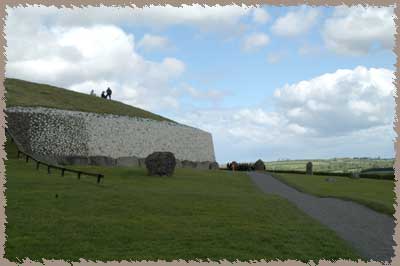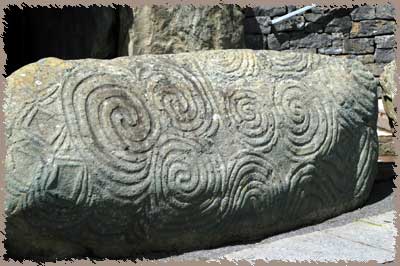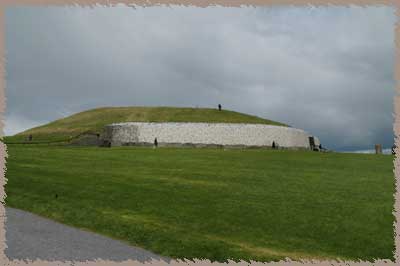
Newgrance
Cº Meath
nr. Drogheda
OS Grid 299274
Brú na Bóinne Center
guided tour only
daily
Mar-Apr, Oct 0900-1730
June - Sep 0900-1900
May 0900-1830
€4.50
Heritage Site
Photos
neolithic sites
abbeys and churches
castles
dublin
waterford
round towers
lovely scenics
Links
travelogueNewgrange Site
Mythical Ireland
101 Fact about Newgrange
Wikipedia
Stone Pages
Megalithic Ireland
Petroglyph Gallery
Ancient Observatories
Irish Historical Mysteries
UNESCO
Megalithomania
Brú na Bóinne Center
Heritage Ireland

approaching newgrange
Coming up on the slightly-flattened hill of Newgrange, it's hard to imagine that this is an entirely man-made structure. Layers of stone and earth, surrounded by enormous stones. I was surprised to learn that the mound had been 'lost' for thousands of years, and it really made me start to look at any other too-regular-looking hump in the earth as another possible passage grave. The gently-rounded hummocks of grass that dot the countryside suddenly take on an entirely new possibility.
 Newgrange is only one of many megalithic burial sites in Meath county -- Knowth, Dowth, Fourknocks, Loughcrew and Tara are the best known. There are 300 passage tombs in Ireland, only a few of which are this size and extent.
Newgrange is only one of many megalithic burial sites in Meath county -- Knowth, Dowth, Fourknocks, Loughcrew and Tara are the best known. There are 300 passage tombs in Ireland, only a few of which are this size and extent.

the huge spiral-designed entrance stone
These mounds in the Boyne Valley date to around 3200BCE, which makes them some of the oldest structures on earth. People still argue whether these are primarily burial mounds (they are technically passage graves), temples, observatories, or something else entirely. It seems unlikely that the enormous hillocks and stacked stone were built without some large significance -- even if they are burial mounds, they must have ceremonial importance.

there were guys mowing the grass when we arrived...on the top!
Newgrange was "lost" for almost four millennia -- the top of the mound sagged and the stones beneath were covered under layers of turf, just another soft hill in Ireland. It was rediscovered in 1699 when a local landowner started excavating for stones.